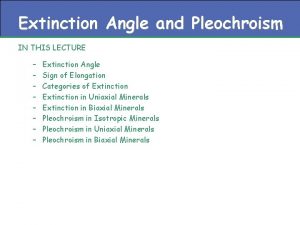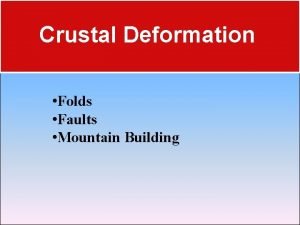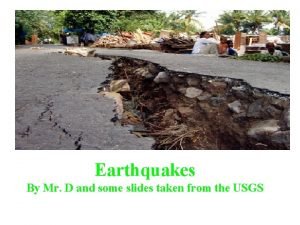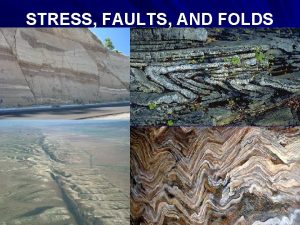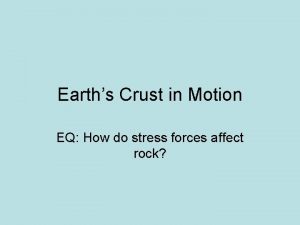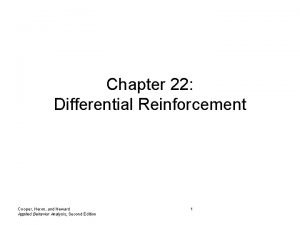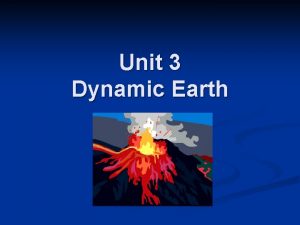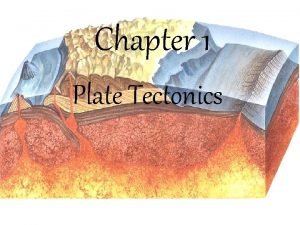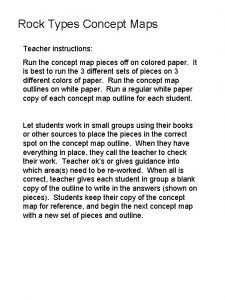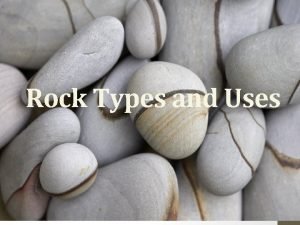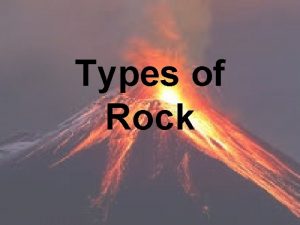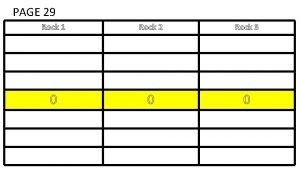Rock DeformationStructural Geology 3 Types of Differential Stress



































- Slides: 35


Rock Deformation-Structural Geology


3 Types of Differential Stress:

Structural Geology - the study of rock deformation. Features of rock deformation are collectively referred to as structure or structural features. Stress and strain - terms used to describe the type of rock deformation

Stress: force applied to a body/unit area 2 Types: • 1. Uniform or confining stress - force on a body that is equal in all directions. Does not usually deform a rock (change shape) but may result in a change in size or metamorphism. • 2. Differential stress - stress that is not equal in all directions and is caused by tectonic forces. Usually causes a change in shape, but not in size.

3 Types of Differential Stress: • 1. Tension - a stretching stress. Rocks have very little strength under tensional stress and break apart easily. • 2. Compression - a squeezing stress. Rocks are relatively strong under compression. • 3. Shear - stress operates in opposite directions across the body

Strain: • Deformation or change of shape a rock body experiences when under differential stress.

3 Types of Strain • 1. Elastic strain /deformation - recoverable strain. • 2. Plastic strain/ ductile deformation permanent strain. When stress exceeds the strength of the rock will bend or fold • 3. Brittle strain/deformation - permanent strain. When stress exceeds the strength of the rock will break or fracture

• Elastic strain /deformation = recoverable strain. When stress is removed, object regains original shape. (Ex: rubber band). • elastic limit - limiting stress beyond which the rock can not return to its original shape and will be permanently deformed. Depends on type of rock involved and temperature.

• Plastic strain/ ductile deformation = permanent strain. When rock is stressed beyond elastic limit and when stress is removed, object remains deformed by bending.

• Brittle strain/deformation - permanent strain. • When stress exceeds the strength of the rock • the rock will break or fracture (Ex: Chalk).


• Factors that influence the type of permanent strain • in rocks experiencing the same amount of stress: • Pressure/Temperature • Confining stress • Time and strain rate • Composition - important in 2 ways: – Mineral composition – Amount of water (fluid) in rock

Sibson, 1977




















 Differential stress in geology
Differential stress in geology Igneous rock to metamorphic rock
Igneous rock to metamorphic rock Engineering vs true stress strain curve
Engineering vs true stress strain curve Axial stress vs normal stress
Axial stress vs normal stress Chapter 10 stress responses and stress management
Chapter 10 stress responses and stress management Stratigraphy
Stratigraphy Compressional stress
Compressional stress Parallel extinction
Parallel extinction Types of folds geology
Types of folds geology Types of earthquakes
Types of earthquakes Type of fault
Type of fault Stress that squeezes and shortens rock
Stress that squeezes and shortens rock Stress that squeezes rock until it folds or breaks
Stress that squeezes rock until it folds or breaks Transcurrent fault
Transcurrent fault How can one type of rock change into another type of rock?
How can one type of rock change into another type of rock? Igneous rock to metamorphic rock
Igneous rock to metamorphic rock Rock climbing rock climbing
Rock climbing rock climbing Chapter 3 standardized test practice answers
Chapter 3 standardized test practice answers Chapter 3 standardized test practice answers
Chapter 3 standardized test practice answers Igneous rock cycle
Igneous rock cycle Exact differential equation
Exact differential equation What is dra in aba
What is dra in aba Margot phaneuf profession
Margot phaneuf profession Swing lock denture diagram
Swing lock denture diagram Types of stress in life orientation
Types of stress in life orientation Function and content words
Function and content words Types of stress
Types of stress Types of stress
Types of stress Rpa rpd
Rpa rpd Albrecht's four types of stress
Albrecht's four types of stress Igneous rocks map
Igneous rocks map What is igneous rock
What is igneous rock Igneous rock concept map
Igneous rock concept map Igneous rocks
Igneous rocks What are the 3 types of rocks
What are the 3 types of rocks Sedimentary rocks leaving cert
Sedimentary rocks leaving cert







